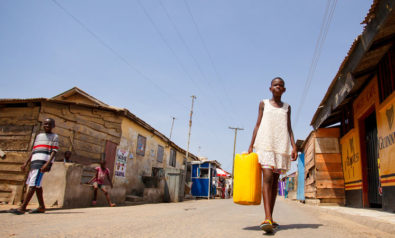To become a transformational force for good, African youths must be employable.
At the African Gold Rush: 2014 NYU Africa Economic Forum, Makhtar Diop, the World Bank’s vice president for Africa, mentioned the fundamental challenges facing the continent. One of these key challenges is equipping Africa’s “greatest natural resource,” its human capital, with “the modern skills and knowledge [it needs] to formulate and implement African solutions for Africa’s challenges.”
At present, Africa is undergoing a population boom. Around 61% of Africans are 24 years old or younger, according to the United Nations World Populations Prospects, while another 34% are aged between 25-59. There has been much speculation about whether the growing youth population will be a curse or blessing. Diop believes it can be an advantage, if the youth are “educated, trained and employable.”
Youth Unemployment and Under-Employability
According to United Nations Africa Renewal, the unemployment rate for sub-Saharan Africa is 6% and youths account for 60% of the region’s unemployed. Populations are growing faster than jobs are being created. Martin Sajdik, the United Nations Economic and Social Council (ECOSOC) president, quoting Tony O. Elumelu in an official tweet, wrote: “By 2020, Africa will need 122 million jobs if we are to succeed in the fight against poverty.”
Who is responsible for creating more jobs? It is ultimately the responsibility of governments to manipulate fiscal policies wisely to create an enabling environment, in which youths can find or create jobs. Reducing taxes, for instance, puts more money into the hands of consumers and incentivizes employers to expand and hire more staff. Likewise, increased government spending on new public projects such as infrastructure creates jobs.
However, unavailability of jobs is not the sole reason for unemployment in sub-Saharan Africa. Sometimes jobs exist but youths are not employable — meaning they do not have the requisite set of skills, knowledge and personal attributes sought after by employers.
The solution to under-employability is complex and requires continuous interaction and cooperation between four major actors: governments, who give accreditation to education providers and approve the curricula or content of study; providers of education; learners (and potential employees); and employers. Cooperation between these actors, bearing in mind national goals and prevailing market conditions, is necessary for devising educational reform that satisfies all stakeholders and reduces the under-employability of African youth.
Tackling Under-Employability
The prevalent prescription for addressing under-employability is to help education providers equip learners with the skills, knowledge and attitudes being sought after by employers. The role of governments and learners is less pronounced, but no less important.
Learners are key stakeholders because they sell their skills in the labor market. Governments are also important because each sub-Saharan African nation is at a different developmental stage, and each is endowed with certain resources giving them varying strategic competitive advantages. Each country, therefore, has different skill needs that must be factored into how they educate and equip their youths for their particular labor markets. For instance, instead of Ghana’s government spending on oil and gas scholarships for their citizens in the western hemisphere, they can reform their higher education institutions to cater to that need. Rwanda, on the other hand, is not a resource-rich country like Ghana and should accordingly focus on educating its citizens for the services industry. There is no one-size-fits-all strategy for sub-Saharan African nations.
The Africa Economic Outlook is the result of a collaboration between the African Development Bank Group, the OECD Development Centre, the United Nations Development Programme, and the Economic Commission of Africa. The outlook argues that for sub-Saharan African economies to be more job-intensive, growth must be accompanied by structural transformation. What this means is there must be a “reallocation of economic resources from activities with low productivity — such as family farming, or petty informal trading — to more productive ones, such as manufacturing.”
At present, economies in sub-Saharan Africa are focused on exporting their primary products like unprocessed cocoa, timber or extractives, which become inputs for importing countries that add value to these inputs and send the finished products back to Africa at higher prices. It is time that African states start adding value locally. This will help curb youth unemployment by creating local industries and jobs. It will also earn countries in this region foreign exchange, if they can export finished products. In order to ensure the newly created jobs do not go to foreigners, the issue of under-employability of youths needs to be tackled aggressively.
Who is responsible for creating more jobs? It is ultimately the responsibility of governments to manipulate fiscal policies wisely to create an enabling environment, in which youths can find or create jobs. Reducing taxes, for instance, puts more money into the hands of consumers and incentivizes employers to expand and hire more staff.
With input from ministries of education, education providers and other stakeholders, governments should address this challenge by developing nation-specific curricula that provide youth with the skills, knowledge and attitudes needed to partake in the structural transformation and industrialization of their economies.
That said, employability involves more than simply redesigning curricula. The universities of Oxford and Cambridge have respectable curricula, yet they produce graduates who are less employable than lesser-known institutions. One reason for this might be a disconnect between employers and these well-known universities. Sub-Saharan African countries must foster communication and cooperation between education providers and employers. Any person conversant with Africa will know this two-way communication and cooperation is largely nonexistent.
The Reality on the Ground
In sub-Saharan Africa, the prerequisite for acquiring the foundational skills necessary for decent jobs is completing lower secondary school. Millions in this region are not able to attain this. According to the EFA Global Monitoring Report, 69 million adolescents worldwide were out of school in 2011. About a third of them were in sub-Saharan Africa and, of this group, the majority were female. Somehow the notion still persists in this region that if families have meager resources to pay for education, then it is more advantageous to educate the male. The gender gap in education impedes development.
The EFA Global Monitoring Report adds: “Unplanned growth in private schooling appears to be excluding many of the continent’s more disadvantaged adolescents.” In Ghana, for instance, because public universities are few and unable to cater to the demand for higher education, many private universities have sprung up to meet the excess demand. Private universities charge market rates that exclude the poor from accessing their services. But this is not the only dilemma. Of the favored few youths who are able to enroll in either public or private universities, many exit the system unemployable.
Where graduates are employable, they are confronted with a labor market fraught with nepotism and cronyism. Instead of jobs being secured based on merit, many secure positions on the basis of who pays the highest bribe.
Governments are responsible for ensuring an enabling environment for young people to become entrepreneurs. But in many sub-Saharan African countries, the youth will tell you this is not the case. Instead of facilitating starting new businesses, government bureaucracies sometimes unintentionally do the opposite by frustrating young Afropreneurs, who must struggle through layers of red tape. Additionally, transaction costs are significantly high due to corruption. These challenges inhibit young people from creating employment opportunities.
Of course, there are exceptional cases where Afropreneurs have broken through and successfully created employment opportunities that have grown by leaps and bounds. But this is the exception and not the norm. Examples of some of Africa’s most successful entrepreneurs include Strive Masiyiwa, Africa’s telecom mogul, and Aliko Dangote, Nigeria’s business magnate.
In conclusion, youth under-employability and unemployment are not insurmountable challenges for sub-Saharan Africa. There is a need for governmental leadership to steer a multi-stakeholder consultative process that matches needs of the labor market with what learners are equipped with. When youths are employable but find it difficult to come across or create jobs, it is once again up to governments to take the leadership in tackling the cancer of corruption and excessive bureaucracies. There is a need for government willingness and capacity to invest time, money and energy in youth resource development. Will African governments take up this responsibility?
That remains to be seen. The expected return on this investment will be that Africa’s increasing youth populations will become a huge asset in driving development, instead of a liability.
*[In partnership with Ashoka’s Future Forward initiative, which is finding innovations for youth employment in Africa, Fair Observer explores the theme: Who is responsible for addressing youth employment in Africa? From June to September 2014, we will be developing online events and a series of articles that will gather multiple perspectives and provide a 360° analysis on the topic. Join the conversation by following and contributing to #AfricaYouthFwd through social media channels.]
The views expressed in this article are the author’s own and do not necessarily reflect Fair Observer’s editorial policy.
Support Fair Observer
We rely on your support for our independence, diversity and quality.
For more than 10 years, Fair Observer has been free, fair and independent. No billionaire owns us, no advertisers control us. We are a reader-supported nonprofit. Unlike many other publications, we keep our content free for readers regardless of where they live or whether they can afford to pay. We have no paywalls and no ads.
In the post-truth era of fake news, echo chambers and filter bubbles, we publish a plurality of perspectives from around the world. Anyone can publish with us, but everyone goes through a rigorous editorial process. So, you get fact-checked, well-reasoned content instead of noise.
We publish 2,500+ voices from 90+ countries. We also conduct education and training programs
on subjects ranging from digital media and journalism to writing and critical thinking. This
doesn’t come cheap. Servers, editors, trainers and web developers cost
money.
Please consider supporting us on a regular basis as a recurring donor or a
sustaining member.
Will you support FO’s journalism?
We rely on your support for our independence, diversity and quality.





















Comment